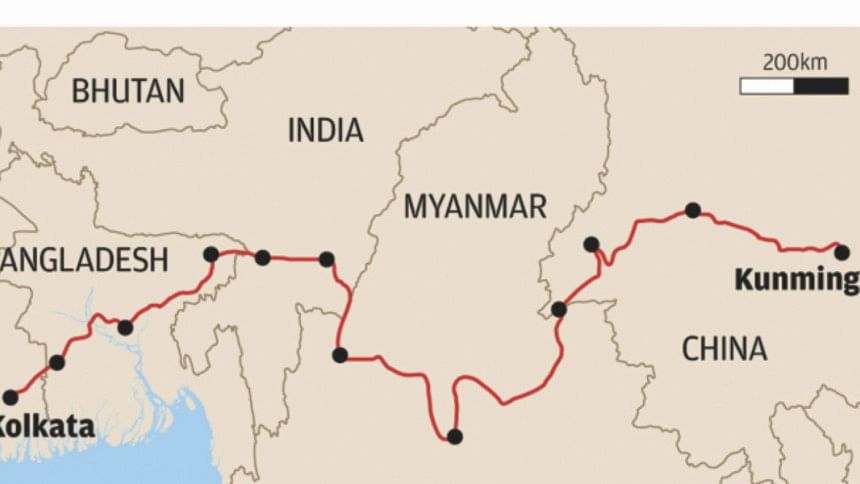Closer China-Bangladesh ties shouldn't worry India

It would have passed as a purely academic event had it not been centred around Indo-Bangla relations and a thought-provoking remark made by an esteemed guest speaker from India.
Professor Sabyasachi Basu Roy Chaudhury, vice chancellor, Rabindra Bharati University, Kolkata gave a special talk at the Asiatic Society auditorium in Dhaka on November 21. He spoke on the theme "Indo-Bangla relationship in the light of history" as reported in Prothom Alo the following day.
Professor Chaudhury's speech stands out for an exceptionally candid, if not a politically impeccable, statement: "China is now a 'thorn' in the relations between India and Bangladesh."
Elaborating the point he said, "China is now Bangladesh's largest trading partner. Bangladesh purchases most of its arms and weapons from the country. Chinese President Xi Jinping during his visit to Dhaka declared a huge commitment to invest (USD 22 billion) in Bangladesh. The latter agreeing to part of China's massive One Belt One Road (OBOR) project has caused worries to India."
All this is common knowledge and took years to reach the stage it has. But the professor's attention to detail speaks volumes about closer Indo-Bangladesh ties.
We needn't however begrudge the "thorny" allusion to the China factor. These are the reasons why:
- It may reflect inner Indian anxiety to settle some of the long-standing issues with Bangladesh so as not to give extra mileage to Beijing.
- Professor Chaudhury has spoken as an academic so that his use of the metaphor for a country being a "thorn" between two countries can't be taken as an official Indian opinion.
- India and China being two giant neighbours of Bangladesh, it is in Dhaka's interest to cultivate balanced and incremental relations with both countries. Yet it is not Bangladesh-driven alone. On the contrary, a strong reciprocity of interest is evinced by both New Delhi and Beijing in Bangladesh's location-centred importance.
Despite Doklam, India-China trade has topped the USD 90 billion mark and is projected to be around USD 402 billion by 2020. Trade balance is currently heavily tilted towards China with Indian imports far outstripping its exports to China. This is topped up by a diverse set of investment linkages between the two Asian giants
Being a friendly neighbour to both India and China, Bangladesh too wants vigorous trade and investments with them. Thus there needn't be any reservations on such issues in this era of economic primacy.
At one point, regarding financing of Sonadia deep sea port or any massive infrastructure project we made it clear we would prefer consortium funding to individual country investment. This visualised partnership for progress with shared stakes.
Professor Chaudhury, while recalling the achievement of Ganges water-sharing treaty of 1996, lamented the failure to resolve the problems of sharing waters of 54 common rivers (including Teesta). His recipe is to engage all countries and states—from the origins to the emptying-out points of the rivers—in discussion for a sustainable resolution of the water issues.
One can only cite BG Verghese's famous book titled Waters of Hope. It advocated for regional or basin-wide cooperation for sustained equitable and multi-purpose utilisation of the region's water resources.
At this point, we need to emphasise the importance of reworking China-India-Myanmar trilateral equations to be energetically responsive to Bangladesh's concerns over a snowballing multidimensional Rohingya crisis. Experts in the west as well as in Asia have even likened the situation to Syrian and Palestinian crises in prospect.
A stable and advancing Bangladesh economy is in the interest of both China and India. The issue of radicalism that large-scale persecution ignites will have to be put out. The region is exposed to risks of terrorism if the root cause which can be eliminated now with relative ease is allowed to unnecessarily rankle.
The army in Myanmar has been termed as a "deep state syndrome". A Dhaka international meet has prescribed punishing the perpetrators of ethnic cleansing and a Human Rights Council meet scheduled at the UN for December 5 is likely to make a similar call to hold those responsible to account for their crimes against humanity in Myanmar.
"India and China contest for influence over Myanmar" is the title of an analysis by Dr MS Prathibha in The Kootneeti published on October 4. China sees Myanmar as a gateway to the Indian Ocean while India activated its Look East policy since Narasimha Rao days in 1991 which is now in full gear aimed at establishing physical connectivity between its northern states and Southeast Asian countries via Myanmar.
In this context, China is spearheading an initiative for Bangladesh and Myanmar to resolve the Rohingya repatriation question on a bilateral basis. Thus a responsibility devolves on China to bring the issue to a satisfactory conclusion.
Finally, why don't we bring the connectivity projects to the table in which Bangladesh is a common denominator with Myanmar, India and China? What has happened to BIMSTEC (Bay of Bengal Initiative for Multi-Sectoral Technical and Economic Cooperation) and BCIM (Bangladesh, China, India and Myanmar) Economic Corridor?
Shah Husain Imam is adjunct faculty at East West University, a commentator on current affairs and former Associate Editor, The Daily Star.
Email: [email protected]





Comments